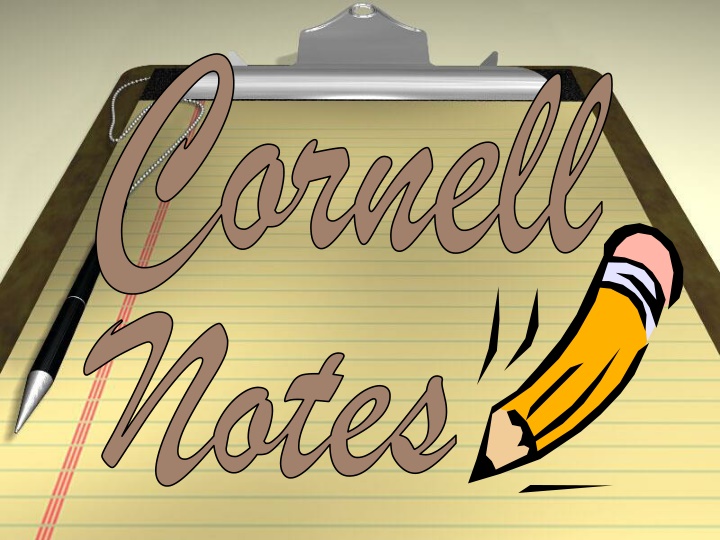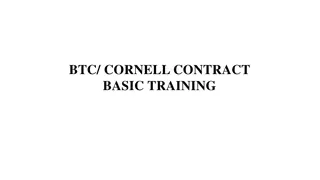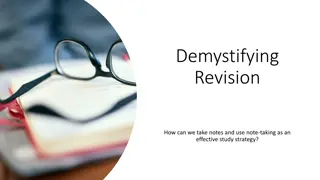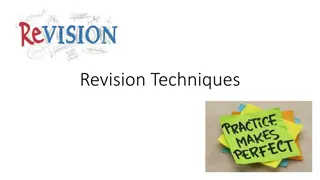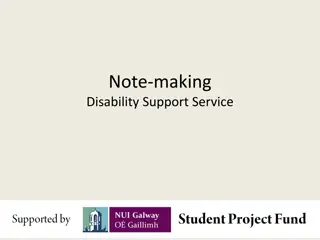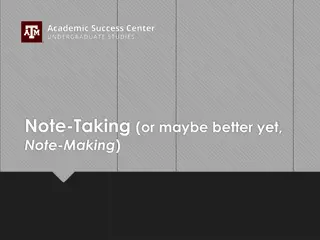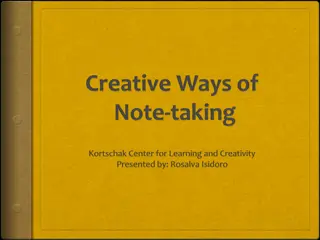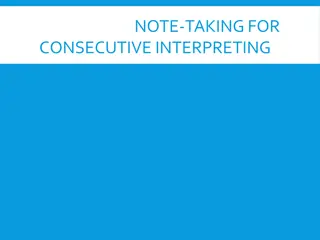Enhance Note-Taking with Cornell Method
Improve your note-taking skills with the Cornell Method, a structured system designed to help you retain information, organize content, and enhance critical thinking. This method emphasizes summarizing, reviewing, and engaging with notes to maximize learning and comprehension. Explore the benefits of Cornell Notes and learn how to effectively implement this technique in your study routine.
Download Presentation

Please find below an Image/Link to download the presentation.
The content on the website is provided AS IS for your information and personal use only. It may not be sold, licensed, or shared on other websites without obtaining consent from the author.If you encounter any issues during the download, it is possible that the publisher has removed the file from their server.
You are allowed to download the files provided on this website for personal or commercial use, subject to the condition that they are used lawfully. All files are the property of their respective owners.
The content on the website is provided AS IS for your information and personal use only. It may not be sold, licensed, or shared on other websites without obtaining consent from the author.
E N D
Presentation Transcript
Cornell Notes
Why take notes? Cornell note taking stimulates critical thinking skills. Note taking helps YOU remember what is said in class. A good set of notes can help you work on assignments and prepare for tests outside of the classroom.
Why take notes? Good notes allow students to help each other problem solve. Good notes help students organize and process data and information. Good notes help students recall by getting them to process their notes at least three times.
Why take notes? Writing is a great tool for learning.
Why take notes? How do I know what I learn until I see what I write?
First & Last Name Class Title Period Date Topic Questions, Subtitles, Headings, Etc. Class Notes 2 1/2 A 3 to 4 sentence summary across the bottom, in the Summary section.
Cornell Notes in easy steps: First, set up your paper. *Fold the paper to enlarge the left margin. *Write your name, date, etc. in upper right *Write the topic in upper left Now take notes in the large area to the right After ALL notes are complete, fill the left margin with questions, headings, translations, etc. Last, at the bottom of the last page of notes summarize, in your own words the notes.
Practice Time Lets get out a sheet of Cornell note paper and get ready to practice the skill.
Assignment & Instructions In the large, right hand column, take notes like you normally would. You may use any style of note- taking you wish: outline format, narrative format, symbols, short hand, etc.
Assignment & Instructions Compare notes with a partner. Talk about what you wrote and why. Look for gaps & missed information. Both partners should feel free to add to their notes.
Assignment & Instructions With your partner(s), create questions in the left hand column. What type of questions? All types!
Costa's Level One Questions Level One Simple Questions. Answers are usually found in a book. Asks students to recall information.
Costa's Level One Questions Level One: Complete Recite Count Name Match Define Observe List Describe Identify Recall
Costa's Level Two Questions Level Two: Enables students to process information. Asks students to make sense of the information they have gathered.
Costa's Level Two Questions Level Two: Analyze Categorize Explain Classify Compare Contrast Infer Organize Sequence
Costa's Level Three Questions Level Three: Most challenging to ask and answer. Asks students to go beyond the concepts they have learned and to apply what they have learned.
Costa's Level Three Questions Level Three: Imagine Plan Extrapolate Evaluate Generalize Apply a Principle Invent Judge Predict
Questions Your questions can reflect: Info. you don t understand or want to discuss. Info. you think would appear on an essay test. Gaps in your notes.
On your own, at the bottom of the page, complete a 3 or 4 sentence summary of what you wrote in your notes.
Let's Review What goes where on Cornell Notes?
Cornell Notes Questions, subtitles, etc. go here, in the left hand column. Remember, we want higher level critical thinking questions. Don t forget the heading: Name, Class, Period, Date, Topic Notes go here, in the large right hand column. A 3 to 4 sentence summary down there on the bottom.
Practice Time Set your paper up and get ready to take notes Cornell Notes
